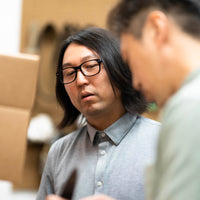Blacksmith Profile: Kisuke Manaka-san
There are many hidden, unknown and remote blacksmiths in Japan. Once upon a time, Kisuke Manaka-san was one of them.
I first discovered his beautiful works of knife art on his Instagram account (@manaka_hamono_tanrenjo), where his beautiful yet rugged knives drew me in. The more I read about him on his website, the more Instagram posts I saw, the more I couldn’t resist contacting him directly. When I decided to visit Japan for some skill and knowledge training, I asked Manaka-san if he would do me the favour of showing me his workshop. Luckily, he agreed to do so!
So there I was, in the middle of Saitama prefecture, visiting a blacksmith that not many people know about.
I got a good impression as he picked me up at the station. He is relatively young (for a blacksmith), very nice and has a great smile. I was prepared to walk to his workshop, but he was even kind enough to drive me. This came as a huge relief, since I was hauling a huge 70lb suitcase full of knives and sharpening stones across Japan with me.
Kisuke Manaka-san is the 5th generation blacksmith at Manaka Hamono. He began his blacksmithing career and started forging knives around 2010, when he married into a knife-making family. At the time, he thought it was super cool to be a blacksmith, but the reality was that his father-in-law was more of a retailer who sold knives at pop-up stores. He wanted to sell knives that he could confidently and honestly say that he hand-forged himself, and that was what led him to actually start forging knives.

Manaka-san, at work in his new Sanjo workshop.
He started making knives pretty much from scratch. His father-in-law was not able to teach him how, but fortunately, he had a ton of machinery and blacksmithing equipment from his grandfather-in-law. With this equipment and a stack of books on knife-making, Manaka-san began the herculean task of teaching himself to make knives.
He wanted to forge as much as he could on his own, including forge-welding the layered steel in-house, rather than buying it pre-laminated from a factory like many blacksmiths do. He read every book on blacksmithing that he could find, and tried endless different materials, finally perfecting his technique of warikomi forge-welding (splitting a hot piece of soft steel like a hotdog bun, inserting a hard steel core, and forge-welding them together). He even achieved the feat of forge-welding stainless steels, which is not an easy task. All of his knives are now made with his warikomi forge-welded technique, done entirely in-house.

Manaka-san forge-welding soft steel onto harder core steel, using the warikomi technique.
Once he perfected forge-welding, Manaka-san’s focus shifted to perfecting heat treatment. He is a bookworm through and through, reading everything he can get his hands on about various heat treatment techniques for steel, and how they affect the finished products. Although he doesn’t have many fancy machines to help with their cladding and other processes, all of his stainless steel knives are treated with a method called “sub-zero treatment”, which significantly decreases the retained austenite in the blade. The retained austenite will eventually transform to martensite, but this transformation will affect the volume of the steel and thus can cause the knife to bend as it ages. In plain English, this process prevents the knife from warping over time.
Manaka-san has managed to teach himself a massive amount about knife-making and create many of the knives that he envisioned, but living and working in an area void of other blacksmiths has made his journey more challenging than most. Several years ago, he visited Mutsumi Hinoura-san in Niigata, and he was moved and impressed by how knowledgeable, warm and accepting he was. Now Manaka-san calls Hinoura-san his mentor.
Knowing just how much he was missing out on, Manaka-san dreamed of moving to a city with more knifemakers, and in 2025, that dream finally became a reality. Kisuke Manaka-san relocated his workshop to a brand-new space in Sanjo, Niigata, surrounded by masters such as Hinoura-san, Masashi Yamamoto, and many others. While Manaka-san was doing incredible work as a self-taught maker, this move has given him the chance to share ideas with and learn from other masters and ways of knifemaking. He's just now resumed his work, and I'm eager to see where this change takes him in the future.
 Manaka-san's latest work, his legendary ENN and KOKUENN series.
Manaka-san's latest work, his legendary ENN and KOKUENN series.






